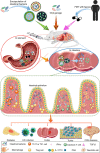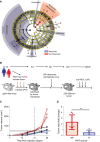Intestinal Bacteria Encapsulated by Biomaterials Enhance Immunotherapy
- PMID: 33643302
- PMCID: PMC7902919
- DOI: 10.3389/fimmu.2020.620170
Intestinal Bacteria Encapsulated by Biomaterials Enhance Immunotherapy
Abstract
The human intestine contains thousands of bacterial species essential for optimal health. Aside from their pathogenic effects, these bacteria have been associated with the efficacy of various treatments of diseases. Due to their impact on many human diseases, intestinal bacteria are receiving increasing research attention, and recent studies on intestinal bacteria and their effects on treatments has yielded valuable results. Particularly, intestinal bacteria can affect responses to numerous forms of immunotherapy, especially cancer therapy. With the development of precision medicine, understanding the factors that influence intestinal bacteria and how they can be regulated to enhance immunotherapy effects will improve the application prospects of intestinal bacteria therapy. Further, biomaterials employed for the convenient and efficient delivery of intestinal bacteria to the body have also become a research hotspot. In this review, we discuss the recent findings on the regulatory role of intestinal bacteria in immunotherapy, focusing on immune cells they regulate. We also summarize biomaterials used for their delivery.
Keywords: biomaterial; immune cell; immunotherapy; intestinal bacteria; oral delivery; probiotic.
Copyright © 2021 Liu, Li, Wu, Jing, Li and Fang.
Conflict of interest statement
The authors declare that the research was conducted in the absence of any commercial or financial relationships that could be construed as a potential conflict of interest. The reviewer XW declared a shared affiliation with several of the authors YL, ZL, YW, LL, XJ, XF, to the handling editor at time of review.
Figures








Similar articles
-
The Probiotic Compound VSL#3 Modulates Mucosal, Peripheral, and Systemic Immunity Following Murine Broad-Spectrum Antibiotic Treatment.Front Cell Infect Microbiol. 2017 May 5;7:167. doi: 10.3389/fcimb.2017.00167. eCollection 2017. Front Cell Infect Microbiol. 2017. PMID: 28529928 Free PMC article.
-
Diet, Microbiome, and Cancer Immunotherapy-A Comprehensive Review.Nutrients. 2021 Jun 28;13(7):2217. doi: 10.3390/nu13072217. Nutrients. 2021. PMID: 34203292 Free PMC article. Review.
-
Efficient protection of microorganisms for delivery to the intestinal tract by cellulose sulphate encapsulation.Microb Cell Fact. 2020 Nov 26;19(1):216. doi: 10.1186/s12934-020-01465-3. Microb Cell Fact. 2020. PMID: 33243224 Free PMC article.
-
Murine Fecal Microbiota Transplantation Alleviates Intestinal and Systemic Immune Responses in Campylobacter jejuni Infected Mice Harboring a Human Gut Microbiota.Front Immunol. 2019 Sep 24;10:2272. doi: 10.3389/fimmu.2019.02272. eCollection 2019. Front Immunol. 2019. PMID: 31616437 Free PMC article.
-
The Role of the Gut Microbiome in Colorectal Cancer: Where Are We? Where Are We Going?Clin Colorectal Cancer. 2020 Mar;19(1):5-12. doi: 10.1016/j.clcc.2019.07.006. Epub 2019 Jul 15. Clin Colorectal Cancer. 2020. PMID: 31678050 Review.
Cited by
-
New Therapeutic Approaches for Allergy: A Review of Cell Therapy and Bio- or Nano-Material-Based Strategies.Pharmaceutics. 2021 Dec 14;13(12):2149. doi: 10.3390/pharmaceutics13122149. Pharmaceutics. 2021. PMID: 34959429 Free PMC article. Review.
-
Cracking the intestinal lymphatic system window utilizing oral delivery vehicles for precise therapy.J Nanobiotechnology. 2023 Aug 10;21(1):263. doi: 10.1186/s12951-023-01991-3. J Nanobiotechnology. 2023. PMID: 37559085 Free PMC article. Review.
-
Cancer cell membrane-coated bacterial ghosts for highly efficient paclitaxel delivery against metastatic lung cancer.Acta Pharm Sin B. 2024 Jan;14(1):365-377. doi: 10.1016/j.apsb.2023.08.012. Epub 2023 Aug 19. Acta Pharm Sin B. 2024. PMID: 38261850 Free PMC article.
-
Tumor microbiome metabolism: A game changer in cancer development and therapy.Front Oncol. 2022 Jul 25;12:933407. doi: 10.3389/fonc.2022.933407. eCollection 2022. Front Oncol. 2022. PMID: 35936744 Free PMC article. Review.
References
Publication types
MeSH terms
Substances
LinkOut - more resources
Full Text Sources
Other Literature Sources

